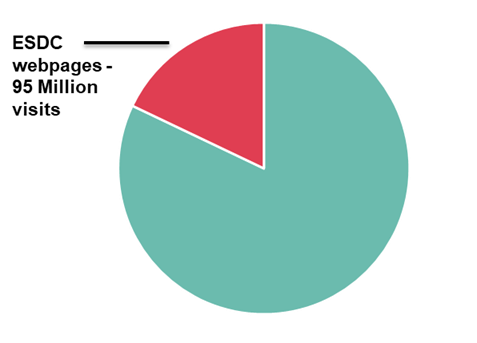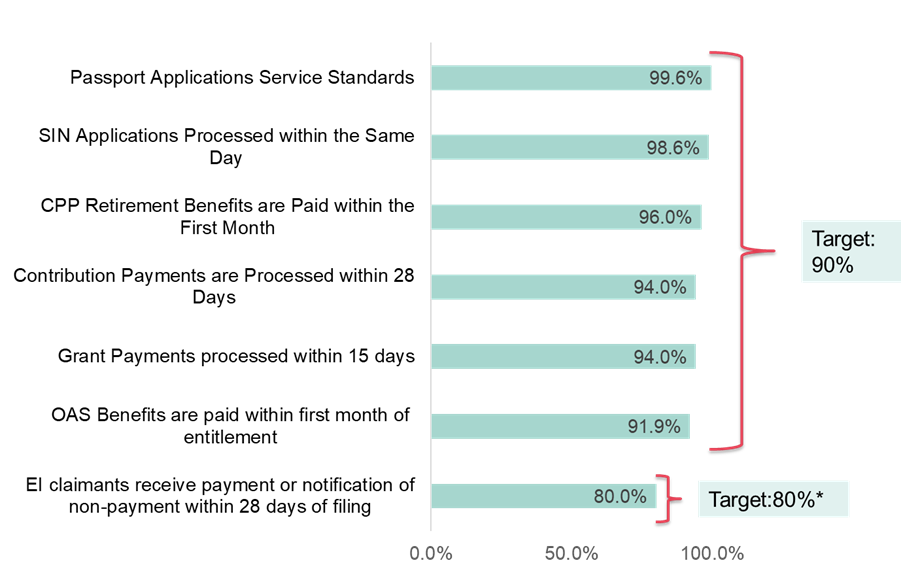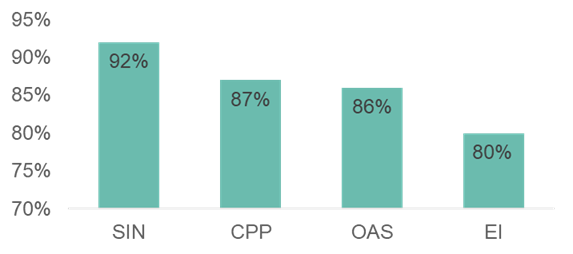Service Canada: Proudly serving Canadians
From: Employment and Social Development Canada
Outline of presentation
Mandate
- Service Canada provides services and information in communities across the country, and plays an essential role in providing benefits to citizens at every stage of their lives
- Liberal platform includes commitment to move forward with ambitious new goals to make sure that people are more satisfied with the service they receive from government agencies and departments
- Service Canada is ESDC’s principal platform to deliver on this commitment, and to make tangible and lasting improvements to the well-being of millions of Canadians
Key programs and services that help Canadians
- ESDC delivers $122 billion in direct benefits to Canadians, representing 5.5 per cent of Canada’s GDP
- Service Canada delivers most of these services and benefits, including:
- Employment Insurance ($16.6 billion, 2.1 million recipients)
- Canada Pension Plan ($46.5 billion, 6 million recipients)
- Old Age Security and Guaranteed Income Supplement ($53.4 billion, 6.3 million OAS and 2 million GIS recipients)
- Other critical supports and services include:
- Social Insurance Numbers (1.6 million)
- Grants and Contributions (over 30 programs, $1.8 billion)
** All data are 2018-19.
Engaging with partners
- Service Canada delivers services on behalf of other government departments and the Government of Canada:
- Domestic passport program on behalf of Immigration, Refugees and Citizenship Canada (2.91 million)
- 1-800-O-Canada and Canada.ca
- Service Canada works in collaboration with other orders of government:
- Strategic co-location to support citizens, ie. ServiceOntario
- Service agreement with the Government of Northwest Territories in 15 remote communities
- MyAlberta Digital ID project
- Federal, Provincial and Territorial Deputy Ministers’ Table on Service Delivery Collaboration
- Public Sector Service Delivery Council
Service Canada structure: National business lines
Citizen services
Responsible for in-person, outreach, passport services, My Service Canada Account, Canada.ca and 1-800-O-Canada
Transformation and benefit delivery services
Responsible for delivering EI, OAS, CPP and major business transformations, including Benefits Delivery Modernization
Integrity services
Responsible for fraud detection and prevention for Service Canada programs; security and privacy of data; as well as protection for temporary foreign workers (regulatory enforcement as per Immigration and Refugee Protection Act)
Program operations
Responsible for delivering over 30 Gs&Cs programs, as well as the Temporary Foreign Worker Program (including Labour Market Impact Assessments) and Work-Sharing Program.
Service Canada presence from coast to coast
Major citizen-facing federal presence in communities across the country, with 20,000 employees organized into four regions: Western Canada and Territories, Ontario, Quebec and Atlantic.
611 In-Person sites*
- 318 Service Canada Centres
- 247 Scheduled Outreach Sites
- 31 Service Canada Centre – Passport Service Sites
- 15 Service Delivery Partner Sites
65 Operations centres*
- 11 CPP/OAS Sites
- 24 EI Sites
- 2 Passport Processing Sites
- 21 Call Centres (includes 2 Passport Call Centres)
- 5 Insurance Payment Operational Centres
- 2 Specialized Sites
**As of June 2019
Clients can access Service Canada services online….
- 47% of major services delivered by ESDC can be fully carried out online using self-service
- 99% of EI applications are submitted online (2.7 million applications)
- 50% of eligible seniors are automatically enrolled in OAS, with more than 1.1 million seniors auto-enrolled since 2013
- My Service Canada Account (MSCA) had 32.2 million logins
- Canada.ca receives 530 million visits, including 95 million visits to ESDC webpages

Figure 1: Total visits to Canada.ca 530 million – Text version
| Types of visits | Total Visits to Canada.ca |
|---|---|
| Visits to non-ESDC webpages | 435 |
| Visits to ESDC webpages | 95 |
Clients can access Service Canada services by phone…
- 1-800-O-Canada answered 1.58 million general inquiry calls
- Our specialized call centres received 27.2 million calls
- Calls are either resolved in the Interactive Voice Response (IVR) system or answered by a call centre agent
- Key statistics:
- 26 million calls to the EI, CPP and OAS call centres (73% IVR; 27% agent)
- 1.2 million calls to the Passport call centres (48% IVR; 52% agent)
- 501,100 calls to the Employer Contact Centre (18% IVR**; 82% agent)
- A dedicated phone service is available to Members of Parliament and their offices to resolve client issues, plus an MP Service Portal is available for information about Service Canada programs and services
** IVR was introduced in Oct. 2018
Clients can visit Service Canada in person…
- There were over 10.4 million visits to Service Canada Centres and Service Canada/Passport Services sites last year
- More than 97% of the population has access to a Service Canada Centre within 50 km
- SCC sites:
- Issue Social Insurance Numbers
- Offer assistance with and receive applications for EI, CPP, OAS and passports
- Provide support for clients to access online services
- Provide general program information
…and Service Canada goes directly to clients
- Staff travel to scheduled outreach sites in rural and remote areas to provide access to the same services available at an SCC
- We also deliver a Community Outreach and Liaison Service targeting individuals and communities with additional barriers to service and requiring support to access benefits
- Service Canada visited 669 Indigenous communities
- When mass layoffs occur, Service Canada reaches out to employers and workers to offer information sessions related to EI, work-sharing and other supports, usually within 48 hours of a known layoff (eg. softwood and automotive industries, major retail)
How we measure success – Part I

Figure 2: Service standards are met in critical areas of our business – Text version
| Service Standard | Performance |
|---|---|
| EI claimants receive payment or notification of non-payment within 28 days of filing | 80.0% |
| OAS Benefits are paid within first month of entitlement | 91.9% |
| Grant Payments processed within 15 days | 94.0% |
| Contribution Payments are Processed within 28 Days | 94.0% |
| CPP Retirement Benefits are Paid within the First Month | 96.0% |
| SIN Applications Processed within the Same Day | 98.6% |
| Passport Applications Service Standards | 99.6% |
2018-19 Results *We do not expect to meet this target in 2019-20 – see slide 16
How we measure success – Part II
- Overall client satisfaction with Service Canada’s service experience is high at 85% in 2018-19.
- A survey of clients of our largest programs shows that most do well:

Figure 3: Satisfaction by program – Text version
| Program | Satisfaction Rate |
|---|---|
| SIN | 92% |
| CPP | 87% |
| OAS | 86% |
| EI | 80% |
- Similarly, 85% of clients find our services easy to use; 84% found them to be effective; and 89% indicated staff are helpful
- When we ask clients about their satisfaction with our service channels:

Figure 4: Satisfaction by channel – Text version
| Channel | Satisfaction Rate |
|---|---|
| In-Person Services | 87% |
| Online Services | 79% |
| Specialized Call Centres | 75% |
Where we have work to do
- For persons with disabilities, 79% report being satisfied with service, but that drops to 62% for persons with restrictions to their ability to self-serve
- Satisfaction with CPP-D is at 62% (compared to 87% for regular CPP)
- When processing inventories are high and cause payment delays, citizens turn to call centres, which then struggle to meet client demand and service standards
- We need to continue to build capacity to address fraud risk, given the materiality, and to provide appropriate security and privacy protection for Canada’s personal information
- Clients often find our online information is not written in plain language
- Just slightly more than half (56%) of users indicate that the information found online is easy to understand
- Only 45% of clients with restrictions say that being able to complete the steps online makes the process easier
Key challenges – Part I
- ESDC infrastructure for benefits delivery needs major renewal if we are to remain effective and meet the needs of Canadians
- Chronic underinvestment has led to significant aging of our legacy IT systems and network, leaving them at risk of service interruptions, and impeding the ability to quickly implement policy, program and business process changes. OAS uses a 56 year old system, while EI relies on over 150 custom solutions built over 47 years
- IT systems underpinning the income support programs are at the end of their lifecycles, are increasingly fragile, and need to be stabilized and modernized
Key challenges – Part II
- Partially automated work processes lead to inherent inefficiencies, increased risk of error, mounting work loads, delays in payments, and higher costs to maintain status quo results
- Service Canada faces workload pressures on key programs:
- Over the next decade, the number of pensions beneficiaries is expected to grow by 50%
- Changing work patterns are driving greater complexity in EI applications, already affecting the timeliness and efficiency over our services (approaching 500,000 applications/decisions in inventory)
- The Department is forecasting that it will not meet its Speed of Pay target of 80% this fiscal, which will be the first time in the past 5 years. Current forecasts see a decline to 77% in 2019-20, 65% in 2020-21 and 60% in 2021-22.
- Temporary funding has supplemented A-Base funding for EI, CPP and OAS for many years, and additional funding will be necessary to maintain service delivery to Canadians over the near term
Key challenges – Part III
- Service Canada’s high levels of client satisfaction overall do not capture the clients that do not apply due to barriers
- Significant numbers of Canadians do not apply for benefits, including Indigenous people, seniors, low-income families and people with disabilities
- Barriers exist that prevent some clients from applying for benefits and programs; these include accessibility as well as complexity, distance, internet availability, culture and language
- Outreach to Indigenous people has demonstrated that we can break down these barriers
- Focused effort is required to continue to simplify online processes, communicate clearly and provide personal support when needed
Opportunities
- Drive to meet existing service standards: Additional workload funding will be required to address growing inventories and meet citizen expectations; [Seven words redacted]
- Stabilize legacy systems: Work is already well underway, supported by Budget 2019, to migrate OAS to a more stable platform, with completion scheduled for December 2020
- Benefits delivery modernization: We propose comprehensive business and IT improvements to modernize and replace legacy systems. Client improvements will roll out gradually, including more digital services, automatic enrolment and secure two-way communication with clients. [One sentence redacted]
- Reaching all Canadians: Progress has been made (ie. improving Canada Child Benefit uptake on-reserve), but work is still needed to reach vulnerable groups by removing barriers to online services and providing support to those who need it, either directly or through partnerships. [One sentence redacted]
Annex A: In person regional network
Total regional network*
- 318 Service Canada Centres
- 247 Scheduled Outreach Sites
- 31 Service Canada Centre – Passport Service Sites
- 15 Service Delivery Partner Sites
611 In-Person Sites
Western Canada and Territories Region
249 In-Person Sites
- 98 Service Canada Centres
- 127 Scheduled Outreach Sites
- 9 Service Canada Centre – Passport Service sites
- 15 Service Delivery Partner Sites
Ontario Region
177 In-Person Sites
- 89 Service Canada Centres
- 75 Scheduled Outreach Sites
- 13 Service Canada Centre – Passport Service sites
Quebec Region
98 In-Person Sites
- 74 Service Canada Centres
- 18 Scheduled Outreach Sites
- 6 Service Canada Centre – Passport Service sites
Atlantic Region
87 In-Person Sites
- 57 Service Canada Centres
- 27 Scheduled Outreach Sites
- 3 Service Canada Centre – Passport Service sites
*As of June 2019